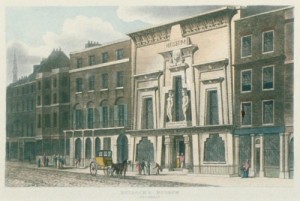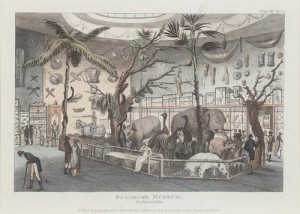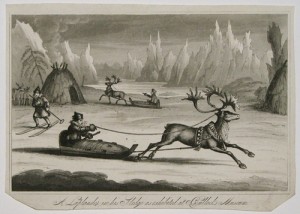By Lucy Inglis (W&M Contributor)
 Eighteenth century Piccadilly was a place for all sorts of curiosities to be displayed. Almost opposite Burlington House, at 170–173 Piccadilly, a Starbucks coffee shop now sits where William Bullock’s Egyptian Hall once stood. From 1798, when Nelson triumphed at the Battle of the Nile, English interest in the ‘East’ began to soar. While obelisks and other monumental pieces had been leaking out of Egypt for a century, Napoleon’s heavy thieving from Luxor and Karnak made Egyptian objects desirable amongst the European elite. The victory of the Battle of the Nile also coincided with a period in which an extended grand tour took in Turkey or Egypt. The romance of the East rapidly took hold of the English upper-class imagination, with books, prints and Eastern costume all the rage.
Eighteenth century Piccadilly was a place for all sorts of curiosities to be displayed. Almost opposite Burlington House, at 170–173 Piccadilly, a Starbucks coffee shop now sits where William Bullock’s Egyptian Hall once stood. From 1798, when Nelson triumphed at the Battle of the Nile, English interest in the ‘East’ began to soar. While obelisks and other monumental pieces had been leaking out of Egypt for a century, Napoleon’s heavy thieving from Luxor and Karnak made Egyptian objects desirable amongst the European elite. The victory of the Battle of the Nile also coincided with a period in which an extended grand tour took in Turkey or Egypt. The romance of the East rapidly took hold of the English upper-class imagination, with books, prints and Eastern costume all the rage.
In 1809, Bullock’s Museum arrived in London from Liverpool. The following year, Bullock turned down the opportunity to display the Hottentot Venus, Saartjie Baartman.His reasons are not recorded. In 1812, the Egyptian Hall was ready for occupation. It must have appeared quite surreal to the man on the street. The grand hall of the interior was an extraordinary replica of the avenue at the Karnak Temple complex, near Luxor. By 1819, Bullock was ready to sell his collection of real and spurious objects, and did so in an auction lasting twenty-six days. It was dispersed all over the world. Emptied of its original tenant, the Egyptian Hall received a new and rather more suitable guest: Giovanni Battista Belzoni, known to his English friends as ‘John’.
An Italian strongman and performer, with an English wife, Belzoni was a true adventurer: in 1817, he travelled to the Valley of the Kings and broke into the tomb of Seti I. From Seti’s tomb, Belzoni took a sarcophagus of white alabaster inlaid with blue copper sulphate of great beauty. The retrieval of the sarcophagus, however, was not without peril: the tomb was located in the catacombs, a maze of traps and dead ends, dug to confuse grave robbers. The French interpreter panicked and an Arab assistant broke his hip in a booby trap. Undeterred, Belzoni retrieved the sarcophagus and brought it to England along with the head of the ‘Younger Memnon’. Belzoni suffered constant vomiting and nosebleeds in Egypt, whilst Sarah was unaffected by so much as a case of sunburn – much to her husband’s chagrin.

London eagerly anticipated the imminent arrival of these treasures. Shelley’s famous poem of 1818, ‘Ozymandias’, was written for a newspaper competition held by The Examinerin advance of the arrival of Belzoni’s treasures. The exhibition opened at the Egyptian Hall in May 1821, but a year later the collection was put up for auction. The sale drew two of the greatest collectors of the day: the British Museum and Sir John Soane. The Museum acquired the colossus and Soane the sarcophagus. John Belzoni, financially if not spiritually satisfied, handed in the manuscript of his travels to his publisher, John Murray, and set off for Benin. He died of dysentery one week after arriving there.

Before long, the Egyptian Hall moved on to displaying real-life Laplanders, who gave sleigh rides up and down the central space. It continued on as an exhibition space until redevelopment in 1904, when this extraordinary Georgian flight of fancy was replaced with offices as part of the great slum clearances.
